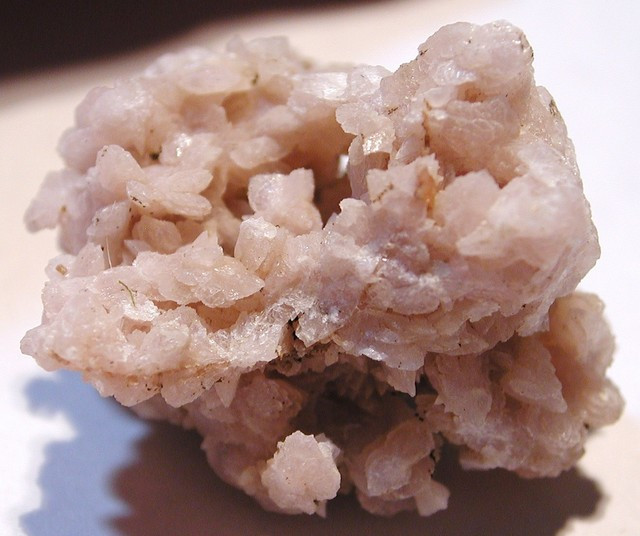
アルバイト宝石:特性、意味、価値など
 アルバイトは長石鉱物の一種で、他の宝石にもよく含まれ、独特の効果を生み出すことがあります。アルバイト自体が宝石なのでしょうか?はい!アルバイト宝石は一般的に白色で半透明です。
アルバイトは長石鉱物の一種で、他の宝石にもよく含まれ、独特の効果を生み出すことがあります。アルバイト自体が宝石なのでしょうか?はい!アルバイト宝石は一般的に白色で半透明です。
アルバイトは岩石ですか、それとも鉱物ですか?鉱物ですが、長石は地球上の岩石の約60%に不可欠な要素です。アルバイトは長石鉱物の中で最も豊富に存在します。
今日は、アルバイトの象徴性、歴史、価格など、アルバイトについて知っておくべきすべてのことについて説明します。

アルバイト石とは何ですか?
アルバイトは、 半貴石、他の宝石の原料、工業用途など様々な用途で用いられます。占星術では、アルバイトは水瓶座の星座石です。
アルバイトが現れる宝石の 1 つにトラピッチェ エメラルドがあります。これは、アルバイト (または他の鉱物) が車輪のスポークに似た 6 角形の模様を生み出す、希少かつ貴重なコロンビア産エメラルドの変種です。
アルバイトは、宝石として用いられる岩石であるバーダイトの一部を構成することもあります。アルバイトが見られる3つ目の宝石はアマゾナイトです。アマゾナイトには白い筋が見られますが、この筋はアマゾナイトの価値を下げる要因となることがよくあります。
次に、アルバイトは工業的にどのような用途に使用されているのでしょうか? アルバイトの最も一般的な工業用途は、ガラス、セラミック、研磨剤、耐火物の製造です。
アルバイトのような長石鉱物も土壌の栄養にとって重要です。これらは通常、地表で風化作用を受け、植物の生育に必要な栄養分を土壌に供給します。また、風化作用によって粘土鉱物も生成されます。粘土鉱物は農業において同様に重要であり、歯磨き粉などの研磨剤や陶器などの装飾品にも利用されています。
アルバイトの仕様と特徴
ほぼすべての種類の長石は、カリウム(またはアルカリ)長石と斜長石の2つの主要な系列に分けられます。アルバイト鉱物は、斜長石長石系列の一部であり、灰長石・アルバイト系とも呼ばれます。
斜長石鉱物は、2つの劈開面の一方に沿って刻まれた溝(条線)の有無で区別できます。いずれもナトリウム・カルシウム・アルミノケイ酸塩で、含まれるナトリウムとカルシウムの量はそれぞれ異なります。
アルバイト長石は少なくとも90%がナトリウムで、カルシウムはほとんど含まれていません。言い換えれば、カルシウムを多く含む斜長石である灰長石は、アルバイトの組成の10%未満を占めています。純粋なアルバイトの化学式はNaAlSi3Oですが、ほとんどの標本は不純です。
アルバイト中のナトリウム含有量の10%以下がカリウムに置換されると、その鉱物はアノーソクレースになります。アノーソクレースは、カリウムを多く含むアルバイトの変種とみなされることもあります。
その他の斜長石鉱物には、灰長石、安山石、オリゴクレース、ラブラドライト、バイタウン石などがあります。
残りのアルバイトの特性は次のとおりです。
モース硬度:6~6.5
色:無色、白、ピンク、赤、黄、緑、灰色
結晶構造:三斜晶系
光沢:ガラス質~真珠光沢、劈開部は真珠光沢
透明性:透明から不透明
屈折率:1.52~1.54
密度:2.57~2.69
谷間: [001]では完璧; [010]では非常に良い; [110]では不完全/不明瞭
骨折:不均一から貝殻状
縞模様:白
発光: 時には蛍光を発し、長波・紫外線では白色。ケニア産の物質はX線ではライムグリーン。
多色性:なし
光学的効果:時にはシャトヤンシー
アルバイトの種類
いくつかのアルバイトの変種と、部分的にアルバイトで構成されている宝石がいくつかあります。それらすべてについて以下で説明します。
ペリステライト
 画像クレジット: 虹色ペリステライト・オリゴクラス長石 | Flickr
画像クレジット: 虹色ペリステライト・オリゴクラス長石 | Flickr
ペリステライトは、オリゴクレースを含む白色または青色のアルバイトの一種で、層状になって虹彩光沢を生み出し、時にはアデュラレッセンス(内部の輝き)さえも生み出します。
その名前はギリシャ語の「鳩」を意味するperisteraに由来しており、鳩の首の羽の虹彩がペリステライトの虹彩に似ていることからきています。
クリーブランド石
 画像クレジット: Parent Géry | Creative Commons Attribution-Share Alike 3.0 Unportedライセンス
画像クレジット: Parent Géry | Creative Commons Attribution-Share Alike 3.0 Unportedライセンス
劈開岩は、薄い板状の板が重なり合った板状のアルバイトの一種です。以前は「カイゼルスパス」や「粒状・放射状アルバイト」と呼ばれていました。
ムーンストーン

ムーンストーンは、乳白色の透明感、真珠のような光沢、そして独特の輝きで知られる、白っぽい青色の宝石です。オレンジ、グレー、グリーンなど、様々な色がありますが、最も一般的なのは白色です。
これらの宝石はアルバイトのみで構成されているわけではなく、アルバイトと正長石が交互に重なり合った層で構成されています。これらの層はムーンストーンの構造を形成するだけでなく、アデュラレッセンスと呼ばれる現象によって、まるで石の内側から光が輝いているかのような印象を与えます。
ラブラドライトとスペクトロライト

ラブラドライトとそのフルスペクトルのフィンランド産変種スペクトロライトは、30~50%のアルバイトと50~70%の灰長石で構成されています。以前の変種と同様に、2つの長石が重なり合うことで、ラブラドレッセンスと呼ばれる独特の虹彩光沢を生み出します。
ママ・シット・シット

マウシットシットは、黒と濃い緑色の脈を持つ、鮮やかな緑色の翡翠のような希少な宝石です。アルバイト、ジェダイト、その他の鉱物からなる岩石です。商標名は「ジェイド・アルバイト」や「クロロメラナイト」ですが、クロロメラナイトは実際には似たような翡翠の一種です。
アルバイトの意味と歴史
アルバイトは、解放、自信、そして困難な変化を乗り越える強さを象徴しています。アルバイトという名前は、その典型的な白色にちなんで、ラテン語で「白」を意味する「 albus 」に由来しています。
アルバイトの歴史的な別名には次のようなものがあります。
アナルバイト
キーゼルプラス
ヒポスクレライト
クリプトス/クリプトクレース
白長石
ホワイトショール
オラフィット
テタルチン
ソーダクラス
酸性斜長石
曹長石
ナトリウム斜長石
ナトロ長石
ソーダ長石
この鉱物の公式な発見は、1815年にスウェーデンの化学者ヨハン・ゴットリープ・ガーンとイェンス・ヤコブ・ベルセリウスがスウェーデンのダーラナ地方で採集した標本について記述したときに行われました。
いくつかの変種、特にマウシットシットは比較的最近発見されたものです。マウシットシットは1963年、スイスの宝石学者エドワード・ギュベリンがビルマで発見した際に初めて発見されました。

アルバイトの治癒特性
他の宝石と同様に、アルバイトの色はヒーリングストーンとしての効能に影響を与えます。アルバイトの多くは無色から白色で、他の白色宝石と同様に、精神の明晰さと浄化作用をもたらします。
ピンクのアルバイトも人気のある選択肢であり、他のピンク色の宝石と同様に、自己愛、ロマンチックな調和、他者への思いやりを促進します。
さて、アルバイトは肉体、感情、チャクラの領域に何をもたらすのでしょうか?
身体の治癒
アルバイトの身体的な効能は、感情的な効能と同様、主に脳に関係しています。アルバイトの結晶は、記憶力を向上させ、認知症、片頭痛、脳卒中などの脳疾患を治療すると考えられています。
さらに、長石は一般的に関節炎、脱毛、皮膚疾患の治療に効果があると言われています。
感情的な癒し
脳は私たちの感情の中心であり、アルバイトは精神面に素晴らしい効果をもたらします。脳を刺激し、より明晰な思考を促すことで知られています。
さらに、アルバイトは、自信喪失、脳の混乱、優柔不断さを取り除きながら、やる気を与え、直感力を高めると言われています。
チャクラヒーリング
チャクラヒーリングは、体内の特定のエネルギーポイント(チャクラ)がブロックされることで生じるネガティブな症状を解消することを目的としています。チャクラを開き、システム全体のバランスを取り戻すことが目的です。
アルバイトは、頭のすぐ上、渦巻くエネルギーの王冠に位置するクラウンチャクラのチャクラストーンです。ここは最高の精神的中枢です。心が閉ざされたり、世界から遮断されたように感じたりするのは、クラウンチャクラがブロックされている症状です。アルバイトでクラウンチャクラを開くことで、より高い意識と、自分のスピリチュアルな力との繋がりがもたらされます。

アルバイト宝石の特性
宝石の専門家は、石がいくつかの異なるカテゴリーのどこに当てはまるかを見て、その石の総合的な価値を判断します。アルバイトの場合、これらの価値特性は、色、カット、透明度、そしてカラット重量です。
まず、アルバイトって何色でしょうか?
色
アルバイトの色は通常無色から白色ですが、ピンク、灰色、赤、緑、黄色、青、さらには黒色の場合もあります。
これらの色(純粋なアルバイトの無色や白色の色合いを除く)は、 内包物によるものです。例えば、緑色の標本は、クロム翡翠に由来することが多いです。アルバイトに含まれるルビーのように、他の宝石と混ざり合う場合もあります。ルビーは灰色で赤い斑点が見られることが多いです。
ほとんどの白色アルバイトはほとんどの買い手にとっていくぶん退屈なものなので、興味深い色であれば石の価値は上がります。
カット
ファセットカットされたアルバイトはそれほど一般的ではありませんが、価値があります。ほとんどは、劈開岩の先端から最初にカットされた無色の宝石です。
アルバイトのほとんどの種類はカボションカットされており、前述のアルバイト石に含まれるルビーやシャトヤント加工が施されたアルバイトもその一つです。それ以外のアルバイトの結晶は、カットされていない原石として販売されています。
明瞭さ
クラリティとは、宝石に含まれる目に見える内包物の量のことです。アルバイト(アルバイト)が含まれる場合が多く、 クラリティグレードはタイプIIまたはタイプIIカラーストーンと評価されることが多いです。
エピドートのような一般的な内包物は通常、アルバイトの価値を下げますが、繊維状の内包物は石にシャトヤンシー、つまり「キャッツアイ」効果を与えると価値を高めます。
カラット重量
透明度の高いファセットカットのアルバイト宝石は、通常1~3カラット程度です。これより大きい宝石は、はるかに価値が高くなります。
シャトヤント(キャッツアイ)アルバイト石は 50 カラットに達するサイズにカットされています。
切断したりサイズを調整したりする前に、アルバイトの結晶はどのように形成されるのでしょうか?

アルバイトの形成と起源
アルバイトには、その形成過程によって低位アルバイトと高位アルバイト(またはアナルバイト)の2種類があります。高位アルバイトは体積が大きく、低位アルバイトを750℃(1,380°F)以上の温度で加熱すると生成されます。
温度が1,050℃(1,920°F)を超えると結晶は単斜晶系となり、モノアルバイトに分類されます。1,100~1,120℃(2,010~2,050°F)を超えると、アルバイトは融解します。
興味深いことに、隕石クレーターでも高位のアルバイトが発見されています。
一般的に、アルバイトは低温で形成される火成岩の内部に形成されます。最も多く見られるのはペグマタイト、花崗岩、緑色片岩です。
採掘場所
アルバイトはどこで産出されますか?宝石品質のアルバイトは主にミャンマー、マダガスカル、ブラジルから産出されます。アメリカ合衆国バージニア州も、高品質でファセット加工可能な無色の結晶を産出することで知られています。クリーブランダイトはブラジル、アメリカ合衆国サウスダコタ州、バージニア州が主要な産地です。
その他の重要なアルバイト宝石の産地には以下のものがあります:
オーストリア
カナダ(アルバイトとペリステライト)
ケニア
マダガスカル
スカンジナビア半島
南アフリカ
重要な質問の時間です: アルバイトの価値は何ですか?

アルバイト石の価格と価値
ファセットカットされたアルバイトは最も希少で、特に色付きのものは価格が最も高くなります。ファセットカットされた作品のほとんどは淡いピンク色で、1カラットあたり50ドルから300ドル近くまで価格が変動しますが、多くは1カラットあたり100ドル前後です。
アルバイトを特徴とするカボションやタンブルストーンのほとんどはアルバイトにルビーが混ざったもので、1個あたり5ドルから40ドルの範囲です。ムーンストーンのカボションも同様の価格です。
最も高価な種類はマウ シット シット(クロロメラナイトまたは翡翠アルバイトと呼ばれることもあります)で、カボション 1 個あたり約 500 ~ 800 ドル、または 1 カラットあたり 12 ~ 25 ドルです。
アルバイト原石はほとんどの場合、他の石と組み合わせられるため、他の石の価値が原石の価格に影響を与える可能性があります。例えば、トパーズ原石と組み合わせたアルバイト原石は1カラットあたり0.15~0.30ドル、鮮やかなブルーやグリーンのトルマリンと組み合わせたアルバイト原石は1カラットあたり50ドルに達することもあります。
アルバイトのケアとメンテナンス
アルバイトは標準的な宝石のお手入れが必要ですが、劈開性があるため、強く鋭い衝撃を受けると破損する可能性があります。このリスクを軽減するために、保護セッティングが施されたアルバイトジュエリーをご購入いただくことをお勧めします。
アルバイトは、ぬるま湯と中性洗剤を混ぜたものに浸した柔らかい歯ブラシで安全に洗浄します。石鹸カスを洗い流し、柔らかいマイクロファイバークロスで乾かしてください。
傷がつかないように、アルバイトは他の宝石とは分けて保管してください。湿気は、原石の場合、時間の経過とともに風化のような劣化を引き起こす可能性があるため、乾燥した環境で保管するのが最適です。

アルバイトに魅せられて?
他の宝石ほどキラキラと輝かないかもしれませんが、アルバイトは多様性に富み、虹彩やアデュラレッセンスといった独特の光学的効果を放ちます。ありふれた鉱物でありながら、アルバイトは他の宝石とは一線を画し、通りすがりの人々の目を引くこと間違いなしです。
Gemstone Encyclopedia検索
最新記事
鮮やかな赤い模様と文化的意義で珍重される希少な宝石、チキンブラッドストーンの歴史、特性、価値、お手入れのヒントをご紹介します。
8th Dec 2025
ゲイラス石は、乾燥しやすいため白濁しやすい希少鉱物で、主に工業用途で使用されています。この完全ガイドで、ゲイラス石の歴史、特性、用途、そして特徴をご覧ください。
7th Dec 2025
チオライトは、氷晶石に似た、無色から白色の希少鉱物です。宝石としては非常に希少で、限られた産地からしか産出されません。チオライトの用途、歴史、価格、特徴についてはこちらをご覧ください。
5th Dec 2025
記事のカテゴリ
How To's is where you will find helpful articles from gem Rock Auctions on how to cut gemstones, select gemstones and buy gemstones.
9記事数
